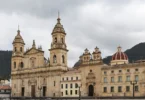Introduction
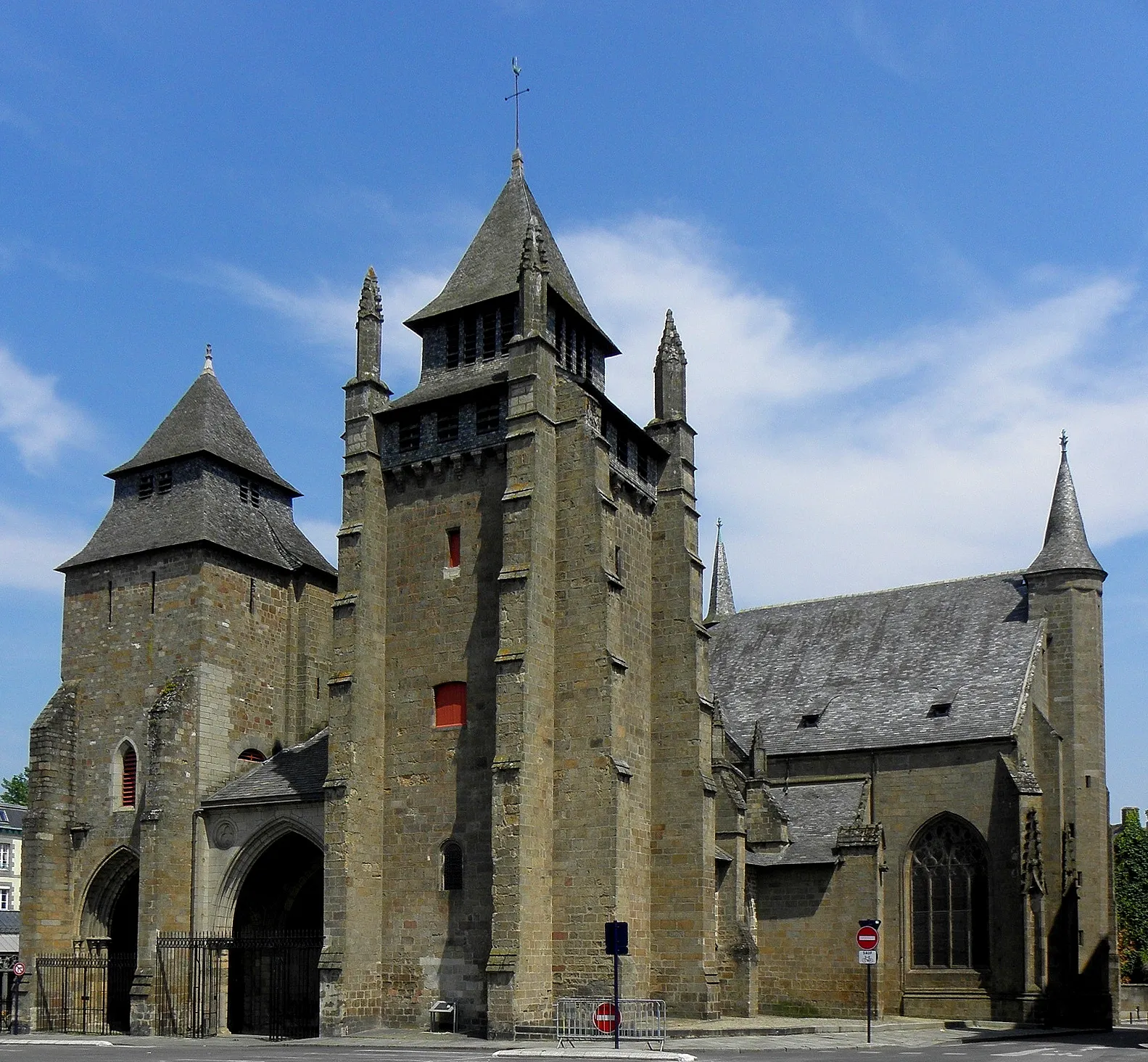
Saint-Brieuc Cathedral (French: Basilique-Cathédrale Saint-Étienne de Saint-Brieuc) is a Roman Catholic church located in the town of Saint-Brieuc, Brittany, France, and dedicated to Saint Stephen. The cathedral is the seat of the Bishop of Saint-Brieuc and Tréguier. It was declared a minor basilica on 3 September 1875. It is a listed monument historique since 1906.
The Cathėdrale St-Étienne on the Place du Gėnėral de Gaulle in Saint-Brieuc has the look of a fortress, and did, in fact, fulfil the role of a church-fortress (“cathédrale-forteresse”) on many occasions when the town was laid siege to in earlier times. The central porch is flanked by two sturdy towers: the 14th-century Tour Brieuc. which is 92 feet high and the 15th-century Tour Marie, which is 108 feet in height. These towers have loop-holes and machicolations which would have allowed the use of a variety of defensive weapons and are supported by stout buttresses. The two arms of the transept jut far out and are protected by towers with pepper-pot roofs. Although stripped of many of its treasures by the zealots of the French Revolution, it still holds many splendid artefacts and works of art. The Chapelle de l’Annonciation has, for example, a superb baroque altarpiece and the organ was built by Cavaillé-Coll, famous for having built the organ in the Church of Saint-Sulpice in Paris. The south arm of the transept is lit by 15th-century stained-glass windows and the tomb of Saint-Guillaume is amongst the many tombs and enfeu scattered throughout the building. The cathedral has an 18th-century pulpit and some interesting Stations of the Cross carved in 1958 by Georges Saupique
Brieuc was born in the 5th or 6th-century in Wales and at an early age was entrusted to the care of Saint Germain. He stayed in Germain’s monastery until he reached the age of twenty-four when he was made a priest. He decided to travel to the Armorican peninsula and set off with a group of monks, his mission to convert the local people to Christianity. He founded a monastery at what is now Tréguier but when called back to Wales because of a terrible plague there, he left his nephew Tugdual in charge. When he returned he found Tugdual totally in control and set off along the Léguer estuary, landed where Saint-Brieuc stands today and founded a monastery after firstly setting up a modest oratory. Later he had the first cathedral built and took the role of bishop for himself.
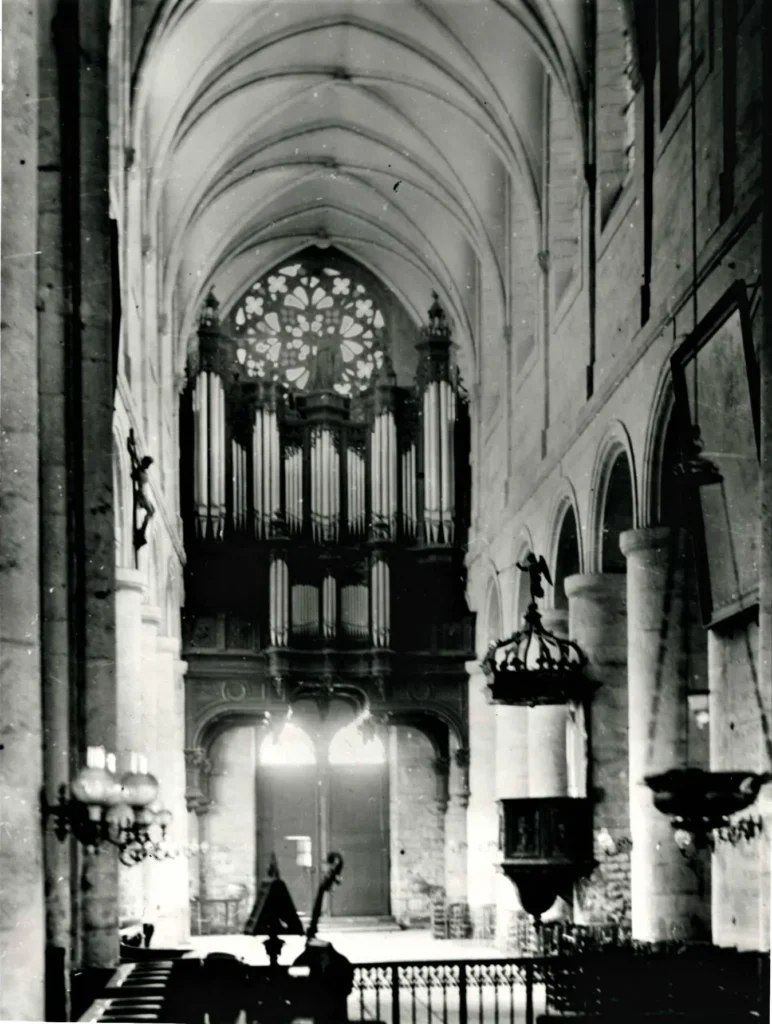
The History of Saint-Brieuc Cathedral dates back to the 6th century, when the first church or oratory was built on the site, initially in wood. A replacement structure was erected around 970, but unfortunately, nothing remains of these early buildings today. During the 10th century, the cathedral and town endured frequent attacks by the Normans, which prompted the relocation of Saint-Brieuc’s relics to the Saint-Serge Abbey in Angers for safekeeping. The cathedral as we see it today began construction around 1180, under the leadership of Bishop Geffroy de Hénon. The building advanced significantly, and by 1212, Bishop Pierre was buried at the base of the Tour Brieuc. Bishop Pierre had also brought the relics of Saint-Brieuc back to the town from Angers in 1210, symbolizing the restoration of the town’s spiritual heritage.
Construction continued under Bishop Guillaume Pinchon, who arrived in 1220. His work on the west façade progressed until his exile to Poitiers in 1228 after a conflict with Pierre Mauclerc. Upon his return in 1231, Pinchon oversaw the addition of a chapel on the south side of the cathedral, dedicated to Saint Mathurin. Pinchon wished to be buried there, and this occurred in 1234. His successor, Bishop Philippe, completed the construction and oversaw the canonization of Bishop Pinchon in 1247, just before departing for the Holy Land in 1248. Over a century later, the cathedral suffered significant damage during the War of the Breton Succession, as well as from a devastating fire at the end of 1353. Following the fire, Bishop Guy de Montfort prioritized rebuilding and oversaw the completion of the choir between 1354 and 1357. Under Bishop Hugues de Montrelais (1357–1375), the cathedral was largely finished, but in 1394, it was again damaged during a siege by Olivier de Clisson. Bishop Guillaume Angier took charge of the restoration, completing the choir and finishing the long-awaited construction of the Tour Marie.
Bishop Jean de Malestroit later reconstructed the gable of the north wing of the transept, commissioning a magnificent window that was unfortunately destroyed in a storm in 1735. By the early 15th century, the cathedral was finally completed, and between 1460 and 1472, Bishop John Prigent added the Chapel of the Annunciation. The cathedral underwent further restoration in the 19th and 20th centuries, including repairs to the vaulting and work on the window framing. As this brief history illustrates, the cathedral was rebuilt several times due to both military attacks and natural disasters, each restoration contributing to the architectural grandeur that stands today.
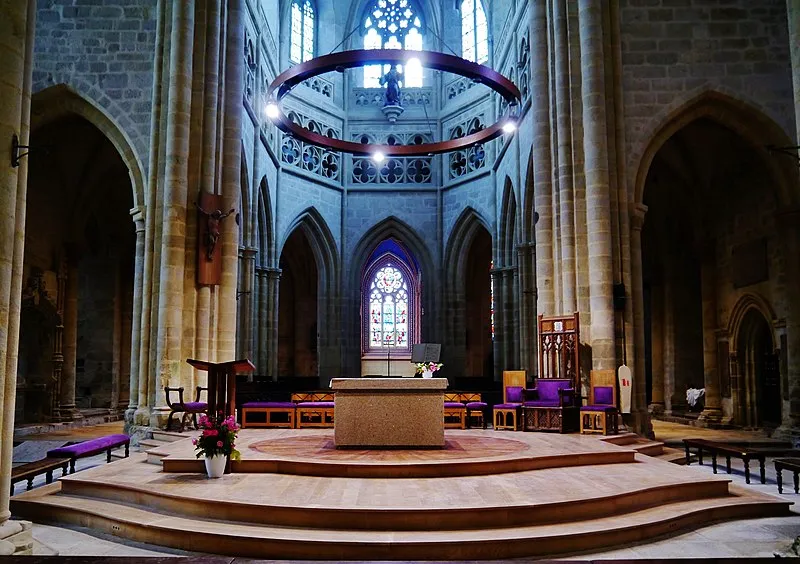
Architectural Style: Gothic Architecture
Interior
The remains of many canons of the cathedral are buried under the paving of the south aisle of the nave and an enfeu holds the tomb of Monseigneur Le Porc de la Porte who died in 1632 and was bishop at Saint-Brieuc from 1618 to 1632. The gisant on the tomb dates to the 17th century. This tomb came to the cathedral in 1833 when the Ursulines chapel had been destroyed. Le Porc de la Porte had founded that chapel.The nave has seven crossings with aisles and to the right of the fourth crossing is the Chapelle des Fonts Baptismaux which has a 16th-century granite font decorated by Alain de Léon. The chapel contains an oil painting depicting John the Baptist at work. To the right of the last three crossings is the Chapelle de l’Annonciation whilst along the north side of the nave is the Porche du Martray and the Sacristy. The transept has two symmetrical wings and the main altar stands on a platform in the centre. The north wing of the transept had some beautiful fenestration dating to the early 15th century, but this was destroyed in a huge storm in 1735. The windows were replaced in 1852 and restored in the 20th century. The Choir is surrounded by a circular ambulatory from which emerge various side chapels.
Exterior
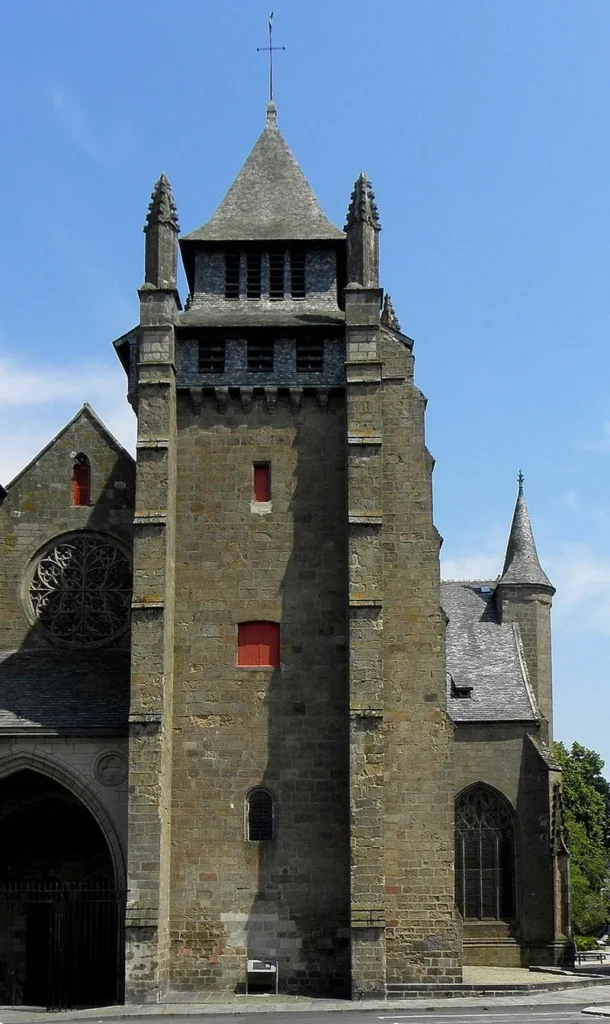
The best entrance to Saint-Brieuc Cathedral is through the West Porch. From here, six steps lead down to the nave, providing an ideal view of the altar located at the crossing of the transept. Originally constructed in the 15th century alongside the south tower, the West Porch was entirely rebuilt in 1888. Its gable dates back to the 13th century, though it was modified in the 14th century and later enhanced with a rose window in the 16th century. Two doors open into the cathedral, with a trumeau featuring a statue of the Virgin Mary, which originated from the Chapelle Saint-Colomban in Peumerit-Quintin. The North Porch, known as the “du Matray,” was reconstructed in 1856. Its tympanum is adorned with a polychrome wood sculpture titled “Une Vierge à l’oiseau” (Virgin with a Bird). In the 15th century, the Sacristy was added between the arm of the transept and the north aisle of the nave.
The north gable of the transept features a large window, which was destroyed during the French Revolution and completely replaced in 1852. Above it stands a clock tower from 1836, which replaced an earlier tower dating back to 1618. The cathedral has two towers. The Tour du Nord, or Tour Brieuc, stands 28 meters tall and holds two bells. The taller Tour du Midi reaches 33 meters and contains three bells. Constructed in the 15th century following the sieges of 1375 and 1394, the Tour du Midi was later topped with a spire in 1852.
The north transept gable, built using local red granite, features a modern window, as the original was lost during the Revolution. An 18th-century clock tops this gable, which served as the only clock in the town for many years. At the cathedral’s chevet, a small doorway known as the “Porte de la Vierge” leads into the building. Above this door is a small window, which opens to a room once used as the chapter’s prison. The gable of the south transept has an elaborate 15th-century window in the flamboyant Gothic style, a feature funded largely through the patronage of Olivier de Clisson.
The Choir, The Ambulatory and Surrounding Chapels
The Master Altar stands at the center of the transept, surrounded by an ambulatory with 12th-century stylobates and columns, leading to various chapels. On the north side of the choir, the first is the Chapelle Saint-Giles, founded in the 14th century by Blanche d’Avaugour and reconstructed in the 16th century. This chapel, containing a stairway to the upper floors, has a tomb believed to hold Bishop Guillaume VI Anger (died 1404). Next are the Chapelle des Morts de la Guerre and the now-unused Chapelle de Montfort. At the chevet, the apsidal chapel known as La Chapelle Notre-Dame de la Cherche (or Chapelle de la Vierge), built in 1343, displays a 19th-century window by stained glass artist Hubert de Sainte-Marie, alongside two statues of the Virgin Mary and two tombs—of Bishops Guillaume Beschard and Guy Eder. Facing it lies the tomb of Canon François de Boisgelin (1633).
On the south side, the Chapelle Sainte-Anne was founded by Bishop Christophe de Penmarc’h between 1471 and 1505. A marble statue of Monseigneur Augustin David, crafted by Henri Chapu in 1891, is displayed here. The altar features an artwork by Elie Le Goff titled Saint-Brieuc et le miracle des loups, depicting Saint-Brieuc miraculously taming wolves. Also in this chapel are remnants of tombs of Christophe’s nephew Alain de Penmarc’h, a canon at Saint-Brieuc, and Canon Rolland de la Fruglaye.
The Chapelle Saint-Yves, dating to the 15th century, was commissioned by Christophe de Penmarc’h and his brother Louis, and features their family coat of arms on the keystone. This chapel includes a black bronze figure of Christ by sculptor Just André François Becquet and a statue of Saint-Yves by Jean-Marie Valentin (1892). Lastly, the Chapelle des Reliques, originally a 13th-century courtyard, was converted into a chapel in 1897 by Monseigneur Fallières to hold 19th-century reliquaries containing revered relics, including pieces of the True Cross and a thorn from the crown of thorns. This chapel is secured by an intricate iron gate. The cathedral’s most significant chapel is located near the south facade of the nave.
The Chapelle de l'Annonciation or Saint-Sacrement
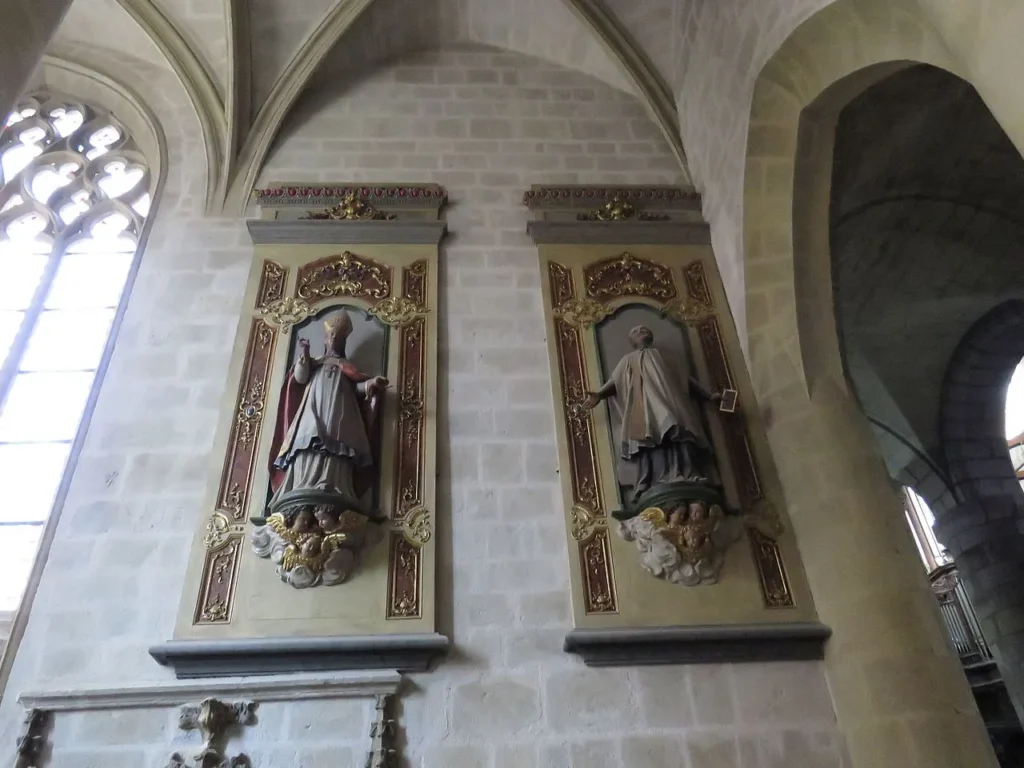
Originally the chapel was dedicated to Saint-Guillaume or Saint-Mathurin and was built between 1462 and 1472 on the initiative of the bishop Jean Prigent, this confirmed by a shield decorating the door in the south of the chapel which bears Prigent’s arms. Prigent’s work on the chapel was completed by his successor Pierre de Laval (1472–1477). The altar “Autel du Saint-Sacrement” dates from the 18th century and was restored in 1977. It was executed by the sculptor Yves Corlay and has panels with relief carvings of the resurrection and the ascension in the central panel. The altar is decorated with statues of the Angel Gabriel, and the Virgin Mary as well as Saint Michael and the guardian angel. On the wall opposite are statues of a mitred Saint-François de Sales on the left and Saint-Vincent-de-Paul on the right. These two saints were founders of the “Congrégation des Dames de la Croix”. The altar had been made originally for the chapel of the “Filles de la Croix” and had been saved during the revolution. As with many baroque altars there is a mirror placed above the altar placed between two angels. It is in the Saint-Sacrement chapel that one sees the enfeus of Monseigneur Le Mée and Monseigneur Fretat de Boissieux.
The Chapel of Saint Guillaume
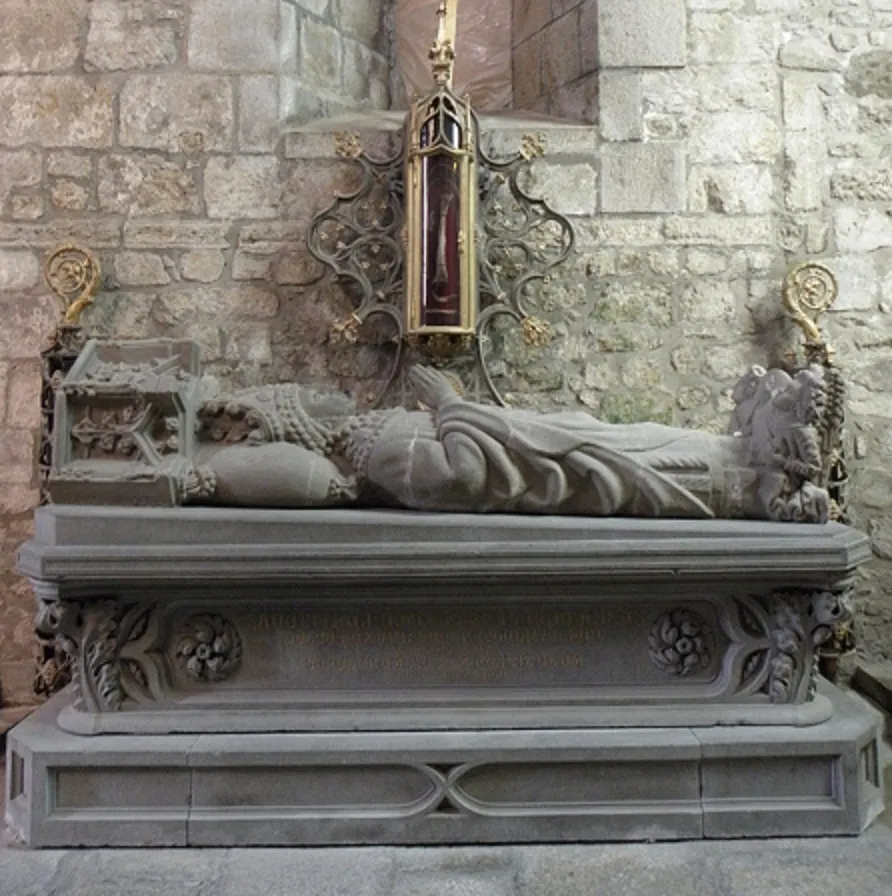
Only in 1956 were Saint Guillaume’s remains placed in this chapel which had in earlier times served as the baptistery. When in the 17th century the fonts were moved to a spot near to the Porche du Martray, the chapel was renamed the Chapelle de Saint-Joseph. The replacement tomb of Guillaume Pinchon can be seen in this chapel which was erected during the 12th and 13th century. The replacement tomb was the work of the sculptor Hernot of Lannion. Pinchon was responsible for much of the 13th-century construction of the cathedral. In earlier days his tomb which dated to the 15th century was located in the Chapelle de l’Annonciation but this was smashed during the revolution. A reliquary sits above the replacement tomb and contains relics of the saint. Also in this chapel is the tomb of Canon François de la Rue buried there in 1861 and the tomb of Monseigneur Martial with a statue by Ogé senior, one of his late works.
The Stained Glass Window of the South Wing of the Transept
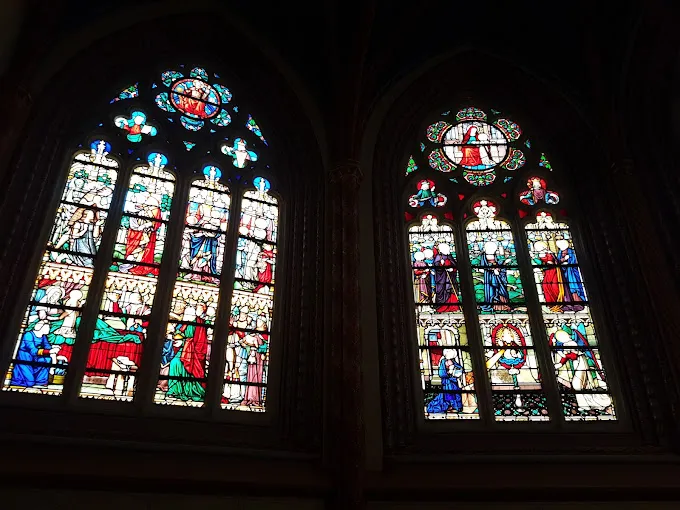
This window is one of the great treasures of the cathedral. A statue of Saint-Yves has been placed on the wall nearby in recent years. It is a 16th-century work and was donated to the cathedral by a family in Chatelaudren. The fenestration itself dates to the 15th century whilst the 60-metre stained glass window dates to 1863. It concentrates on the theme of the eucharist and the sacrement depicts various biblical stories; manna in the desert, the Feeding the multitude story, the Last Supper and the Easter lamb. The two central compartments recall the treaties of Nicée in 325, the Fourth Council of the Lateran in 1215 and the Council of Trent in 1545. Under this window are statues of John the Evangelist and Thomas Aquinas both dating to the 19th century.
The Stained Glass Window in the apsidal chapel the "Chapelle de la Vierge"
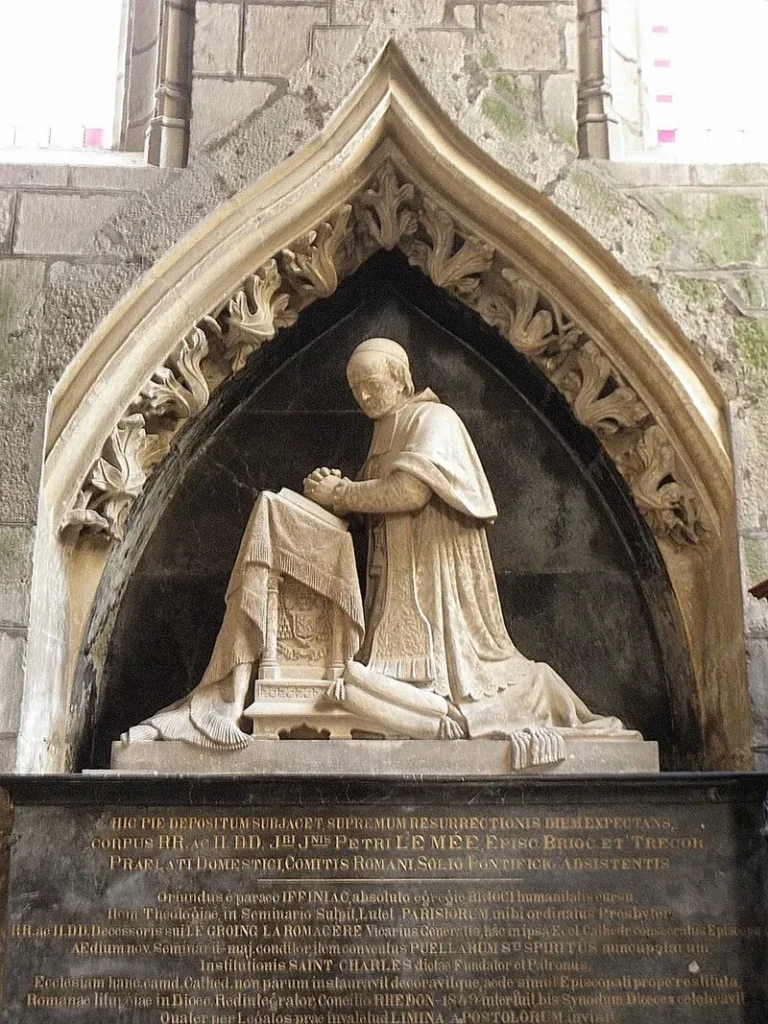
The Cathedral’s Chevet was built in 1343 by Roland de Dinan and Clémence d’Avaugour. On each side of the chapel entrance are statues. One, on the left, depicts the Virgin Mary holding the baby Jesus who holds a bird in his hand. That on the right is an 18th-century statue of the Virgin Mary in gilded wood. The chapel window dates to the end of the 19th century. It depicts events from the life of the Virgin Mary. The panels from left to right depict Mary’s birth, The Annunciation and the visit to Elizabeth, the Dormition and Assumption (this a modern piece the original having been destroyed accidentally), the Nativity, Jesus’ presentation in the temple and Pope Pie IX proclaiming Mary’s Immaculate Conception.
Oil Paintings
The cathedral has an oil painting of Pope Gregory 1 by the artist A Hubert dated 1827. There is also a painting of the “Sainte Famille” and the “Nativity”. This painting dates to the 17th century and whilst the artist is not known it is said to be “after” Jean Jouvenet. Also in the cathedral are the paintings “Le martyr de saint Etienne” by A.d’Hardivillers and “Jesus et le paralytique” by P. Bisson.
Tombs
The cathedral houses the tomb of Monseigneur Jacques Jean-Pierre Le Mée, who served as bishop of Saint-Brieuc and Tréguier from 1841 to 1858, following Monseigneur Le Groing de la Romagère. A dedicated leader, Le Mée was superior of the Filles du Saint-Esprit, held a synod for them in 1851, built a new seminary, and established multiple schools, including Saint-Brieuc’s école Saint-Charles, Guingamp’s Notre-Dame institute, and Saint-Joseph college at Quintin. He passed away on July 31, 1858, at age 64. An effigy of Le Mée, kneeling in prayer, was created by sculptor Pierre-Marie-François Ogé in 1859. His tomb rests in an enfeu that initially held the tomb of Jean Prigent, the original builder of the chapel in 1472, which was later destroyed during the French Revolution. The same enfeu also contains the tomb of Monseigneur Le Groing de la Romagère, with an ornate tomb crafted by Ogé in 1841.
The Cathedral’s Altar
The cathedral’s high altar is made from marble and was made in 1831 at Rennes by Pince based on designs by the architect Richelot. The altar in the transept was created by the Rennes sculptor Hérault in 1854 and is decorated with statues by the sculptor Ogé senior. The cathedral’s cathedra or “trône épiscopal” is the work of the Etienne brothers from Trévé.
The Organ and Organ Casing
The Cavaillé-Coll organ was built in 1848 replacing a much smaller instrument. Aristide Cavaillé-Coll is one of the great organ makers of France. The instrument was classified as a “Monument historique” in 1975. From 1986 to 1988 the organ was restored by Jean Renault. The organ casing or buffet in French was made in the 19th century by the Étienne brothers. They included in the work some panels which came originally from England in 1540. The casing was classified as a “Monument historique” in 1906 when the cathedral itself was similarly classified. The organ is also decorated with a statue of sainte Cecilia by Jean-Marie Valentin.
The Cathedral’s Treasury
By the entrance to the ambulatory a grilled door leads to the Chapelle des reliques called La Petite Trésorerie. The principal relics kept here are those of saint-Brieuc and saint-Guillaume and a thorn from the crown of thorns called “Saint-Bro”.
The Stations of the Cross
The work of Georges Saupique and executed in 1958. They are carved in granite and the sculptor has added two further stations, depicting the Annunciation and the Resurrection.
The Bells
The cathedral has a five-bell peal.The north tower, called the Brieuc Tower (left), houses the two largest bells. The bourdon is located behind the lower louvers, located between the buttresses, meaning that it is relatively close to the ground. Bell 2 is located behind the upper louvers of this tower, at the level of the slate roof. The south tower, called the Marie or Midi tower (on the right), houses the three other bells.
Feast Day
Feast day: 26th December
The feast day of Saint Étienne (Saint Stephen), the patron saint of St Étienne’s Cathedral in Saint-Brieuc, is celebrated on December 26th. Saint Stephen is recognized as the first Christian martyr, and his feast day is observed widely in the Catholic Church.
Church Mass Timing
Every ordinary Sunday, Mass is celebrated from 10:30. a.m. to 11:30. a.m.
Church Opening Time:
Monday : Closed
Tuesday : Closed
Wednesday : Closed
Thursday : Closed
Friday : Closed
Saturday : 2:00 pm – 6:00 pm
Sunday : 10:00 am – 12:00 pm – 2:00 pm – 6:00 pm
Contact Info
Address :
Pl. Général de Gaulle, 22000 Saint-Brieuc, France
Phone: +33296332454
Accommodations
Connectivities
Airway
The Nearest Airport to The Church of St Étienne’s Cathedral, Saint-Brieuc, Saint-Brieuc, France, is, Saint-Brieuc – Armor Airport, 22440 Trémuson, France, which is just 14 min (12.5 km) via N12 away from the basilica.
Railway
The Nearest Railway to The Church of St Étienne’s Cathedral, Saint-Brieuc, Saint-Brieuc, France, is, Saint-Brieuc, 22000 Saint-Brieuc, France, which is just 2 min (550.0 m) via Pl. Général de Gaulle and Rue Vicairie away from the basilica.


